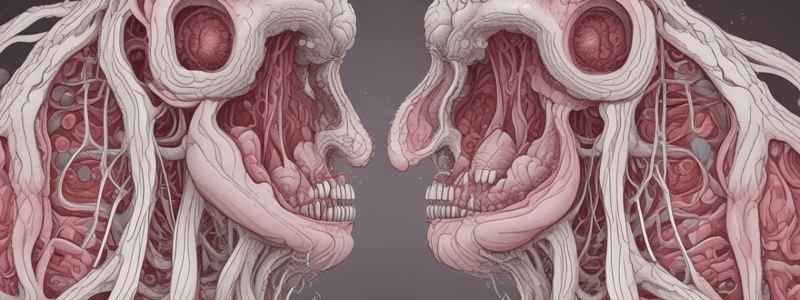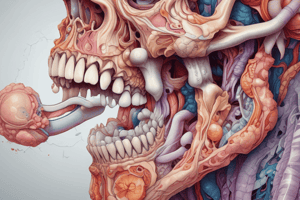Podcast
Questions and Answers
What type of papillae on the tongue does not have taste buds?
What type of papillae on the tongue does not have taste buds?
- Foliate papillae
- Fungiform papillae
- Circumvallate papillae
- Filiform papillae (correct)
Which type of papillae is located at the junction between the posterior ⅓ and anterior ⅔ of the tongue?
Which type of papillae is located at the junction between the posterior ⅓ and anterior ⅔ of the tongue?
- Fungiform papillae
- Circumvallate papillae (correct)
- Foliate papillae
- Filiform papillae
What is the role of Von Ebner glands in the tongue?
What is the role of Von Ebner glands in the tongue?
- They produce mucus that helps to lubricate the tongue
- They secrete saliva that helps to dissolve taste molecules (correct)
- They are involved in the transduction of taste sensations
- They produce saliva that helps to break down food
What is the function of the synapse between receptor cells and nerve fibers in taste buds?
What is the function of the synapse between receptor cells and nerve fibers in taste buds?
How many nerves are involved in transmitting taste information from the tongue to the brain?
How many nerves are involved in transmitting taste information from the tongue to the brain?
Which structure is involved in conscious perception of olfaction?
Which structure is involved in conscious perception of olfaction?
Which of the following is NOT directly related to emotion?
Which of the following is NOT directly related to emotion?
What is the role of the hypothalamus in the olfactory system?
What is the role of the hypothalamus in the olfactory system?
How many main tastes are recognized?
How many main tastes are recognized?
Which structure is involved in the emotional performance of olfaction?
Which structure is involved in the emotional performance of olfaction?
What is the primary function of the ventral-posterior nucleus of the thalamus in the context of taste processing?
What is the primary function of the ventral-posterior nucleus of the thalamus in the context of taste processing?
Which nerve is responsible for conveying somatosensory sensations from the anterior ⅔ of the tongue?
Which nerve is responsible for conveying somatosensory sensations from the anterior ⅔ of the tongue?
What is the primary role of the orbitofrontal cortex in the context of flavour perception?
What is the primary role of the orbitofrontal cortex in the context of flavour perception?
Where are the cell bodies of the glossopharyngeal nerve (IX CN) located?
Where are the cell bodies of the glossopharyngeal nerve (IX CN) located?
What is the primary contributor to the sensation of flavour in food?
What is the primary contributor to the sensation of flavour in food?
What is the primary function of the somatosensory system in relation to food perception?
What is the primary function of the somatosensory system in relation to food perception?
What is the term for a disorder where one perceives a sweet taste as sour?
What is the term for a disorder where one perceives a sweet taste as sour?
What is the purpose of using non-irritating substances in olfactory examinations?
What is the purpose of using non-irritating substances in olfactory examinations?
What is the term for the complete loss of smell?
What is the term for the complete loss of smell?
What is the primary goal of the electrogustometry examination?
What is the primary goal of the electrogustometry examination?
What is the primary mechanism of transduction for sour taste?
What is the primary mechanism of transduction for sour taste?
What is the function of glutamate receptors in taste perception?
What is the function of glutamate receptors in taste perception?
What is the characteristic of receptors involved in sweet taste transduction?
What is the characteristic of receptors involved in sweet taste transduction?
What is the common characteristic of salty and sour taste transduction mechanisms?
What is the common characteristic of salty and sour taste transduction mechanisms?
Where are the receptors responsible for taste perception located?
Where are the receptors responsible for taste perception located?
Flashcards are hidden until you start studying
Study Notes
Taste and Flavour
- The tongue has three nerves and three ganglia, but a single nucleus (destination) for taste information
- Anterior ⅔ of the tongue is responsible for taste and touch, conveyed by the chorda tympani (branch of VII CN) and lingual nerve (branch of V)
- Posterior ⅓ of the tongue is responsible for taste, conveyed by the glossopharyngeal nerve (IX CN)
- Oropharynx is responsible for visceral information, conveyed by the vagus and X CN through the superior laryngeal nerve
Taste and Flavour Integration
- Taste inputs travel to the cortex, relaying through the thalamus, specifically the ventral-posterior nucleus (VPM)
- From the thalamus, taste inputs reach the insula and then the orbitofrontal cortex, where integration with other sensory inputs occurs
- Flavour includes taste, olfaction, and somatosensory inputs
- The orbitofrontal cortex receives visual, taste, somatosensory, and other inputs, and integrates them to form flavour
Olfaction
- Olfaction is responsible for most of the flavour we interpret from food
- When we have a cold, food tastes different due to reduced olfaction
- The olfactory system contacts the hypothalamus to generate autonomic responses
- The olfactory system also connects with the hippocampus, amygdaloid nucleus, and piriform cortex, influencing emotions, memory, and behaviour
Taste
- There are 5 recognized tastes: sweet, salty, sour, bitter, and umami
- The taste bud includes receptors, expressed on gustatory cells, and supporting cells
- Receptors make synapse with gustatory fibres, carrying taste sensation to the brain
- Taste buds are grouped in papillae on the tongue, but scattered in other parts of the oral cavity
Types of Papillae
- Filiform papillae have no taste buds
- Fungiform papillae have taste buds on the lateral wall
- Circumvallate papillae are located at the junction between the posterior ⅓ and anterior ⅔ of the tongue
- Foliate papillae have taste buds and Von Ebner glands, which secrete saliva
Disorders of Olfaction and Taste
- Ageusia: no taste
- Hypogeusia: reduction of taste
- Dysgeusia: misinterpretation of taste
- Anosmia: no olfaction
- Hyposmia: reduction of olfaction
- Parosmia: no correct interpretation of smells
- Cacosmia: a type of parosmia, where everything smells bad
Examination of Taste and Olfaction
- Taste tests: examining main tastes by applying substances to specific regions of the tongue
- Electrogustometry: a test to examine taste
- Olfaction tests: using non-irritating substances to examine olfaction, with each nostril explored separately
Studying That Suits You
Use AI to generate personalized quizzes and flashcards to suit your learning preferences.




